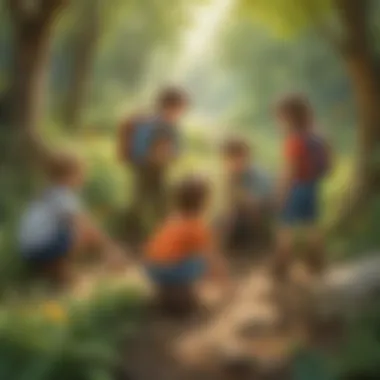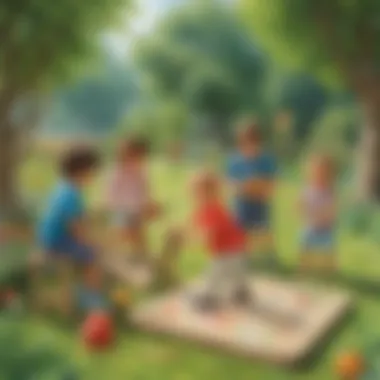Exciting Outdoor Activities for Preschool Development


Intro
Outdoor play is more than just a break from indoor monotony; it's a vital ingredient in the recipe of a preschooler's development. Think about it: young kids are like sponges, soaking up experiences that shape their minds, bodies, and social skills. When they get out into the fresh air, engaging with nature, they aren't just having fun—they're learning in a way that textbooks simply can't replicate. In this article, we’ll dive into the rich landscape of outdoor activities designed specifically for preschoolers. From fostering creativity with engaging crafts to deepening their understanding through educational games, we’ll explore it all. Quickly, we’ll guide you through various safe and stimulating activities that set the foundation for a life-long appreciation of the outdoors.
Creative Activities
Outdoor activities can spark a child’s imagination and be as simple or elaborate as you wish. Creative outlets can encourage preschoolers to express themselves while gaining new skills. Here are some nifty ideas to stir up creativity:
Craft Ideas
- Nature Collage: Gather leaves, twigs, and flowers during a nature walk. Have children use glue to stick them onto paper, creating a unique collage.
- Rock Painting: Find some smooth stones and let kids paint them with colorful designs. They can take these home as fun decorations or hidden treasures.
- DIY Bird Feeders: Use pine cones smeared with peanut butter and rolled in birdseed for a quick and easy craft that brings nature right to your backyard.
Step-by-Step Guides
Crafting outdoors isn’t just fun; it’s a hands-on way for preschoolers to learn and experiment. Here’s how to carry out the rock painting activity:
- Gather materials: rocks, paints, brushes, water, and cloths for cleanup.
- Wash the rocks with water to remove dirt and make them easier to paint.
- Set up a covered surface outside to protect the area from spills.
- Invite children to let their imaginations run wild, explaining how colors mix and how to create different designs.
- Allow ample drying time before handling.
Educational Value
Engaging in outdoor crafts like these helps children develop fine motor skills, enhance creativity, and observe nature closely. It’s an effortless way to mix learning with fun, making art a fitting vehicle for exploration.
"Children learn as they play. Most importantly, in play, children learn how to learn." - O. Fred Donaldson
Engaging Outdoor Games
Games can be a fantastic way for preschoolers to learn teamwork, develop physical skills, and just plain enjoy their time outside. Below are some games that can be tailored to various settings:
- Scavenger Hunt: Prepare a simple list of items for children to find, like a green leaf or a round stone.
- Simon Says: A classic game that can help with listening skills and following directions.
- Nature Bingo: Create bingo cards filled with different plants or animals to spot while on a walk.
Outdoor play for preschoolers is essential for their development and can be wonderfully enriching. With a little bit of creativity, the world outside becomes a limitless canvas for learning and growth.
The Importance of Outdoor Play for Preschoolers
Outdoor play is not just a way for preschoolers to burn off some excess energy; it’s an essential part of childhood development that lays the groundwork for lifelong learning and health. Getting kids outside opens doors to a world where imagination takes flight, discoveries are made, and the foundation of social skills is built. This section explores various facets of outdoor play, underpinning its vital role in nurturing young minds and bodies.
Cognitive Development through Nature
Nature itself is a powerful classroom. When preschoolers venture outside, they engage all their senses. They touch bark, smell flowers, collect leaves, and hear rustling branches. This multisensory experience stimulates their brains, sparking curiosity and imagination. Children begin to understand their environment’s complexities and develop critical thinking skills by exploring and asking questions about what they see. They start to develop classifications, like differentiating between types of plants, or concepts like weather patterns.
Additionally, activities such as nature scavenger hunts can further elevate cognitive skills. Kids learn to identify items and solve problems as they navigate the outdoors. This form of learning is hands-on and deeply impactful. As the saying goes, "You never forget your first climb.", experience is the best teacher.
Physical Health Benefits
Let’s be honest: kids really need to move. Outdoor play encourages children to run, jump, climb, and explore, enhancing their physical health on multiple levels. Regular exposure to physical activity during outdoor play helps in building strong muscles and bones and improving balance and coordination. Furthermore, fresh air and sunlight contribute to better vitamin D levels, which is crucial for overall health.
Playing outdoors also engages children in a natural way to burn calories. A simple game of tag can lead to hours of activity, promoting cardiovascular health. Research has even found that kids who play outside regularly have a lower risk of obesity. Leaving the confines of walls brings an array of benefits; it’s critical for preschoolers to experience a physically active childhood.
Social Skills Enhancement
Outdoor play doesn’t just polish cognitive and physical abilities; it also forms the backbone for nurturing social skills. In open environments, children learn to share, negotiate, and interact. Take a sandbox, for instance—it's a miniature society. Kids learn to take turns with buckets and shovels, navigate conflicts over space, and collaboratively build intricate structures.
Playground games foster teamwork and communication, skills that are essential in both childhood and adulthood. Moreover, being outside can often reduce stress or anxiety associated with structured, indoor play. Kids feel free and equal in nature, allowing friendships to blossom. As a wise proverb notes, "It takes a village to raise a child," which we realize during moments of shared laughter and cooperation in outdoor play.
In summary, outdoor play is a crucial ingredient in a preschooler's daily routine. Not only does it spark cognitive abilities, promote physical health, and strengthen social interactions, it connects children to the wonders of the world around them.
Incorporating a variety of outdoor elements into a preschooler's life is the stepping stone to their well-rounded development.
Types of Outdoor Activities for Preschoolers
Outdoor activities play an essential role in the growth and development of preschoolers. These activities not only enhance physical abilities but also pique curiosity, instilling a love for nature. Engaging kids in various outdoor experiences fosters creativity, nurtures social interactions, and boosts cognitive development. While there’s no shortage of structured activities, the beauty lies in spontaneity, where young children can stumble upon little adventures, shaping their understanding of the world around them.
Nature Walks and Exploration


Nature walks can serve as a foundation for discovery. Taking strolls through parks, trails, or even the neighborhood exposes preschoolers to a vast array of sights and sounds. Children can observe birds, feel different textures of leaves, or listen to the rustling of grass in the breeze. These experiences stimulate their senses and encourage questions, such as "Why do trees have bark?" or "What makes a sound?" By exploring at their pace, kids become mini-experts in their surroundings.
Moreover, capturing what they see through simple sketches or discussions can further enhance their linguistic abilities and observational skills. A parent or caregiver can make it more engaging by introducing themes. For example, focusing on colors one day and shapes the next can enrich their learning. Nature walks, thus, become a canvas for learning as well as a means to burn off some energy.
Gardening and Plant Care
Tending to a garden is like nurturing a life, and preschoolers can find joy in this responsibility. With small pots, soil, and seeds, this activity allows children to witness growth firsthand. Watching a seed sprout into a plant is a transformative experience that imbues them with a sense of accomplishment.
Caring for plants also encourages responsibility. Kids learn about the importance of watering, sunlight, and what each plant requires – lessons that can translate into broader discussions about ecosystems and the environment. Plus, incorporating gardening tools that are their size adds an element of fun. The great thing is, whether it’s indoor herb pots or outdoor flower beds, these tiny gardens can be as simple or elaborate as desired, making them adaptable to various spaces.
Creative Arts and Crafts in the Park
Outdoor spaces serve as the perfect backdrop for creativity. Arts and crafts in a park can be a vibrant experience filled with inspiration. Imagine toddlers with colorful paints, crafting their interpretations of nature on large sheets of paper, or constructing sculptures from twigs, stones, and leaves found nearby. This type of engagement helps develop fine motor skills and encourages imaginative play.
Additionally, the sounds of the park – laughter, birds chirping, or wind whispering – can enhance the creative process. Having a picnic gear or portable art supplies can make the experience seamless. Parents might find that setting up outdoor art events can spark not just creativity in their children, but also work as a social gathering, where kids can share ideas and artworks with peers.
Outdoor Games and Team Activities
The outdoors is a magnificent arena for games and team bonding activities. Simple games like tag, hide and seek, or hopscotch encourage movement, agility, and teamwork. These activities can be tailored to different preferences and age groups while ensuring that every child feels included.
Organizing mini-sports days can be equally effective. Think sack races, relay races, or even three-legged races – these foster camaraderie and help preschoolers learn the value of working together towards a common goal. Not only do these games enhance physical health, but they also foster social skills that aid in forging friendships and resolving conflicts, laying a strong foundation for future interactions.
Building and Construction Play
Engaging preschoolers in building and construction play taps into their innate desire to create. Whether using sand, mud, or construction toys, developing structures offers endless opportunities for imaginative exploration. Building a sandcastle at the beach or making a fort with sticks in the park encourages spatial awareness, creativity, and teamwork as children often collaborate on their projects.
Parents or educators can set up a “building challenge” with different materials, prompting kids to think critically about how to utilize the resources they have. This hands-on experience can led to discussions about architecture, balance, and even physics in a fun and engaging way. Each structure becomes a testament to their creativity and problem-solving skills.
Engaging preschoolers in diverse types of outdoor activities not only entertains them but also lays down crucial life skills, making the years of early development both enriching and enjoyable.
Safety Considerations for Outdoor Play
When it comes to outdoor play for preschoolers, safety must be at the forefront. This is not just a matter of wrapping children in bubble wrap; rather, it's about creating an environment that encourages exploration without unnecessary risks. Outdoor play fuels imagination, promotes physical health, and supports social skills. However, without proper safety measures, it can quickly turn from a joyous activity into a potential hazard.
Choosing Safe Play Environments
Not all parks and playgrounds are made equal. When thinking about where to let little ones roam, a few important factors come to mind. Look for places that are well-maintained, with adequate equipment designed for young children. Soft surfaces like grass or rubber mats can prevent injuries from falls. Check for any debris or sharp objects lying around because you never know when a stray rock can trip up a sprightly little person.
Do the playground equipment meet safety standards? Every piece of equipment should be age-appropriate, as using gear meant for older kids can lead to accidents. A good playground will also be enclosed or clearly marked to help keep children contained and within sight. Also, looking for parks that have clear sight lines for caregivers can be beneficial, allowing a watchful eye on children as they explore various activities.
Supervision Guidelines
Supervision is key in outdoor play. Just because a place seems safe doesn’t mean that kids can run wild without guidance. Situational awareness is a big part of it. Parents and caregivers should keep a close watch while allowing room for independence. Always be engaged and ready to step in.
Setting clear rules before heading out can help too. Children need to know what is acceptable and what is not when it comes to their play. This can include boundaries on where they can run and what they can climb. If they are equipped with understanding, it'll be easier to trust them to explore while ensuring their safety.
"Good supervision doesn’t mean hovering like a helicopter; it’s about being present and attentive."
When in a group, assigning roles can be beneficial. Designate one adult to watch over particular activities, ensuring that everyone has a responsibility. This can alleviate some pressure from an overwhelmed caregiver and make play safer.
Assessing Risks and Hazards
Every outdoor play area has its own set of risks. Before letting preschoolers embark on their adventures, take the time to assess what potential hazards might be lurking around. Here are some factors to consider.
- Weather conditions: One must not underestimate the impact of climate. Wet surfaces can be slippery, while heat can lead to exhaustion or sunburn. Always check the weather before heading out and dress kids appropriately.
- Terrain: Uneven ground or steep hills can pose risks; ensure children know to be cautious when running or climbing steep areas.
- Wildlife: Animals can be a delight, but they can also be unpredictable. Always be aware of your surroundings; teach children not to approach unfamiliar animals.
Regular inspection of play areas can help in identifying new hazards over time. Engaging children in this process can also foster a sense of safety awareness. Everyone should feel empowered to speak up if they notice something off, and this lays a solid foundation of safety values that can carry well into their lives.
Incorporating Learning into Outdoor Activities
Incorporating learning into outdoor activities is crucial for preschoolers as it seamlessly blends play with education. This natural approach not only captures the children's attention but also fosters a love for learning through engagement with the environment. When children experience knowledge in an outdoor setting, it can ignite their imaginations and make complex concepts feel simpler and more approachable. Additionally, outdoor experiences allow for hands-on learning, which is often more effective for young children who thrive on exploration and action.
Activities held outside can effectively touch on multiple educational elements—being exposed to nature can stimulate curiosity, encourage scientific thinking, and enhance communication skills. It’s about discovering how the world works and making connections, whether that’s understanding the life cycle of plants or grasping basic physical principles through playful interactions.


Nature-based Learning Techniques
Nature-based learning techniques are fundamental for developing a child’s understanding of both the environment and themselves. These techniques often emphasize sensory experiences and promote direct interaction with natural surroundings. Such methods foster strong observational skills, which are the bedrock of many learning processes.
- Sensory Exploration: Children can touch, smell, and listen to natural elements. Encourage them to describe their findings; for example, feeling the texture of a leaf, observing the movement of ants, or listening to the rustling of trees. This promotes vocabulary growth and comprehension.
- Storytelling in Nature: Integrating storytelling or role-play in outdoor settings allows children to connect emotionally with concepts. Creating narratives around the environment can deepen understanding—such as telling stories about the critters they see, which can spark feelings of empathy and wonder.
Integrating Science into Outdoor Play
Science for preschoolers doesn't need to be confined within the walls of a classroom. Integrating science into outdoor play brings abstract concepts to life. Identifying insects, exploring weather patterns, or observing plant growth can all become rich learning moments. Children, being naturally inquisitive, can engage in experiments right in their backyards or parks.
- Nature Journals: Introduce the practice of keeping a nature journal where children can record their observations over time. They can draw plants they discover or note changes in the weather, integrating writing and critical thinking skills.
- Simple Science Experiments: Conduct basic experiments, such as exploring buoyancy by making boats and testing them in puddles or streams. This supports active participation in scientific processes and encourages problem-solving.
Fostering Curiosity through Exploration
Fostering curiosity is paramount in preschool education, and outdoor activities are a natural way to cultivate this trait. When children roam freely in nature, they encounter the unknown, which inherently sparks questions.
The key is to create an environment where asking questions is encouraged, and exploration is a part of daily activities.
- Encouraging Questions: Rather than providing all the answers, nurture children’s inquiry by asking them guiding questions. For instance, if they see a bird, ask, "What do you think it is doing?" This instills critical thinking and deepens engagement.
- Exploration Stations: Set up different exploration stations in your backyard or a local park where children can engage with various themes—like a bug observation station or a plant identification zone. Each spot can invite hands-on interaction and promote evaluative thinking.
"Exploration in nature not only nurtures curiosity but also instills an appreciation for the environment, paving the way for lifelong stewardship."
By embedding learning within outdoor activities, preschoolers gain valuable life skills and knowledge in an enjoyable, low-pressure context. This method stands as a call to educators and parents alike: let’s prioritize an enriching, interactive learning journey right outside the door.
Seasonal Outdoor Activities
Engaging preschoolers in outdoor activities across different seasons is crucial for providing them with varied experiences that contribute to their comprehensive growth. Each season offers unique opportunities to explore nature, learn, and play. This diversity keeps children interested and excited about being outside, while also teaching them about the changing environment around them. Seasonal outdoor activities help develop their motor skills, spark creativity, and increase their awareness of the world. These experiences don't just entertain; they lay the groundwork for lifelong skills and appreciation of nature.
Spring Adventures and Learning
Spring often brings a sense of renewal and rebirth, a reminder that nature is full of surprises. As buds begin to blossom and animals emerge, preschoolers can embark on adventures that stimulate their curiosity. One simple yet effective way is through nature scavenger hunts, where caregivers can create lists of items for children to find, like colorful flowers or buzzing bees. This activity not only encourages observation but also enhances vocabulary as children learn new words related to their finds.
Another engaging activity is planting seeds. Helping little ones plant a small garden can teach them about responsibility and the growth process. They can watch their plants progress from seedlings to full bloom throughout the season. This hands-on learning helps them connect with nature in a very personal way.
Summer Exploration and Fun
When summer rolls in and temperatures rise, the world becomes an open playground for children. Water play is a quintessential summer activity that can include everything from splash pads to simple water hose games. Not only is this fun, but it teaches children about buoyancy, motion, and the properties of water.
Outdoor picnics are another wonderful way to celebrate summer days. Involving children in preparing the meal can teach them about healthy eating and food preparation. While enjoying a meal al fresco, they can also engage in games like tag or relay races that promote not only physical activity but also teamwork and cooperation.
Autumn Activities and Discovery
As the leaves turn crimson and gold, autumn presents a different palette of colors and textures. Leaf collecting and art can be a captivating way for children to immerse themselves in this season. After collecting an array of leaves, children can use them for crafts or to create a sensory experience by feeling their different textures. Stories about trees and hibernation add a narrative aspect that can enhance their interest in the changing season.
Moreover, organizing a pumpkin patch visit provides educational opportunities, from understanding the life cycle of pumpkins to the joy of picking out their very own. Each activity can lead to discussions on harvest and gratitude, fostering a sense of community and appreciation for nature.
Winter Play and Learning Experiences
Winter may chill the air, but with proper preparation, it can be a magical time for outdoor fun. Building snowmen or simply enjoying snowball fights can teach kids about physics—snows mass and movement. Those snowy days are perfect for developing gross motor skills through sledding or ice skating in a safe environment.
Winter is also a wonderful time for nature walks to observe how animals adapt to the cold. Discussing animal tracks in the snow can spark curiosity about wildlife. Bringing back twigs and pinecones for crafts can combine learning and creativity, making every winter outing both an exploration and a lesson.
In short, seasonal outdoor activities for preschoolers are vital in shaping their physical, cognitive, and social development. Each season offers distinct experiences that facilitate hands-on learning while inspiring an appreciation for the outdoors.
Engaging children in varied seasonal activities fosters their curiosity, creativity, and connection to nature that lasts a lifetime.
Engaging Families in Outdoor Fun
Engaging families in outdoor activities for preschoolers is more than just a way to pass the time. It creates a goldmine of opportunities for learning, bonding, and wholesome fun. When families step outside together, they don’t just enjoy fresh air; they foster relationships and create lasting memories that are bound to enrich the childhood experience. Families who engage in outdoor fun can help instill a love of nature in their young ones, teaching them about the environment while enjoying quality time together.
Furthermore, outdoor activities can serve as a wonderful lead-in to essential discussions about teamwork, problem-solving, and creativity. It’s a chance to cultivate an appreciation for nature and living things, making it easier for young children to understand the world around them.
Community Events and Activities


Community events and activities can function as the perfect platform for families to immerse themselves in outdoor fun. These are not just organized gatherings; they transform into a collective effort where experiences are shared, and connections are made. For instance, local parks often host nature walks or storytelling sessions that not only engage children but are also an opportunity for parents to mingle and exchange ideas on parenting.
"Community events are like fishing in a pond— you might not catch a big one, but the experience matters more than the end goal."
Many communities will organize seasonal festivals that combine fun activities with learning opportunities. Think about a summer festival featuring a scavenger hunt that encourages children to explore various habitats, learning about flora and fauna along the way. Such interactions are incredibly enriching, providing social and educational aspects that can benefit preschooler development.
Creating Family-Friendly Outdoor Experiences
Creating family-friendly outdoor experiences involves knowledge of your child's interests and the environment around you. Think picnic-style gatherings in local parks where you can combine meal enjoyment with outdoor games. Ten minutes of play with a frisbee could, for instance, turn into learning about angles, speed, and even basic physics—all while having a blast.
Furthermore, crafting outdoor spaces that welcome families can make a massive difference. Consider parks with accessible trails, engaging playgrounds, and inclusive restrooms. Family-friendly experiences also include making resources available for families, like informative guides on local flora, fauna, and ecology. These promotions serve as baselines for educational adventures.
Some ideas for making outdoor experiences family-friendly include:
- Family picnics—bring along tasty snacks and enjoy some blanket time.
- Nature crafts—use leaves, stones, and twigs to create art together.
- Exploration days—plan ‘adventure walks’ to discover hidden gems in your backyard, like butterflies or unique plants.
Encouraging Family Participation in Nature
To effectively encourage family participation in outdoor activities, you need to meet children where they are, using their natural curiosity as a springboard for exploration. Design activities that are straightforward yet impactful. For instance, getting families involved in community gardens can teach them about sustainability while promoting team effort and responsibility.
You can also arrange competitions or challenges—like a family bird-watching event—where each member uses a checklist to find various birds. This adds an element of excitement and friendly rivalry, making the experience memorable.
Finally, offering simple tools to families can lead to increased participation; things like bug catchers, simple telescopes for stargazing, and basic gardening kits can facilitate explorations and make learning fun. Engaging the whole family not only makes outdoor play enjoyable but also effectively layers learning on top of play, building a rich developmental backdrop for preschoolers.
Technology and Outdoor Play for Preschoolers
The intersection of technology and outdoor play is an exciting area that invites innovation into the lives of our preschoolers. In today's digital age, technology can play a crucial role in enhancing outdoor experiences. It paves the way for exploration, learning, and fun, connecting children to the world around them while grounding them in rich outdoor experiences. This section aims to explore how digital tools can be harmoniously blended with outdoor activities, all while keeping the essence of nature-based play intact.
Digital Tools for Outdoor Learning
There’s no denying that screens hold a significant sway over young minds today. However, leveraging technology outdoors can transform what might seem like mere screen time into engaging learning moments. For example, apps that promote wildlife identification or nature exploration can enrich a simple nature walk. Kids can snap pictures of flora and fauna, seeking guidance on what they encounter. These little digital aids don’t just entertain; they expand knowledge and ignite curiosity.
Some popular tools include:
- Nature explorer apps: These can provide details about various plants and animals. They effectively make the outdoors a living classroom.
- Augmented reality games: These can encourage active play while providing a virtual layer that highlights the environment before them.
- Interactive maps: They help preschoolers track their explorations, making every trip feel like an adventure in discovery.
When integrating such tools, it’s important to ensure that they are used as supplements rather than distractions. Focusing on the real-world interactions with nature can foster a deeper appreciation among children.
Balancing Screen Time and Outdoor Activities
While technology offers enriching resources, it’s vital to strike the right balance. Screen time, if left unchecked, can lead to physical lethargy in little ones. Thus, finding a harmonious balance becomes essential. Experts suggest the “30-30 rule,” which advocates for 30 minutes of screen time followed by 30 minutes of outdoor play. This structure encourages movement and activity, urging kids outdoors to act out the stories they've just watched or played.
Tips for maintaining this balance include:
- Set designated screen time for specific outdoor learning apps, ensuring they complement activities rather than replace them.
- Encourage outdoor play that integrates technology without losing focus on nature. For instance, after identifying a plant through an app, let the kids engage in hands-on activities like planting seeds or drawing what they see.
- Lead by example: When children see adults engaged with both technology and outdoor activities, they are more likely to mirror this behavior.
"Outdoor play and technology don’t have to be at odds; instead, they can create an enriched experience fostering both discovery and learning."
The dialogue surrounding technology and outdoor play for preschoolers is continuously evolving. By emphasizing quality time spent outdoors, enhanced by targeted digital tools, we can form a solid foundation for lifelong exploration and learning.
Evaluating and Enhancing Outdoor Experiences
Evaluating outdoor activities for preschoolers is vital. Not only does it ensure their safety, but it also helps in assessing whether the activities truly benefit the children's development and engagement. Observing how children interact with their environment gives insights into their interests and abilities, guiding caregivers to tailor experiences that suit individual needs. Enhancing these experiences means building upon observations, refining activities, and considering feedback, which ultimately fosters a richer learning atmosphere.
Observing and Assessing Activity Impact
Observations are the backbone of evaluating outdoor experiences. Paying attention to how children engage during nature walks or while playing games is crucial. For instance, do they show enthusiasm, curiosity, or creativity? A simple checklist can help make these observations more systematic. Consider noting:
- Engagement Level: Are the kids actively involved, or are they on the sidelines?
- Social Interaction: How well do they share resources or cooperate with their peers?
- Skill Development: Do you notice improvements in their physical abilities or cognitive skills?
In addition to observing behaviors, it’s important to assess the impact of activities in terms of learning outcomes. For example, if a nature scavenger hunt helps children identify different leaves or insects, that’s a measurable success. By regularly taking the time to observe and document these aspects, caregivers can adapt future experiences to either reinforce successful activities or rethink those that didn’t resonate well.
Gathering Feedback for Improvement
Feedback often serves as the essential ingredient for enhancing outdoor experiences. Engaging children in discussions about what they enjoyed or found challenging can provide valuable insights. Simple questions like, "What was your favorite part of our garden activity?" or "Did you find the nature walk too short?" can lead to eye-opening responses. Additionally, it's advantageous to involve parents and other caregivers in these discussions. Their insights play a fundamental role in the overall evaluation process, as they often notice things during family outings that may not be apparent in group settings.
Moreover, creating a feedback loop that includes adjustments based on what you learn can transform outdoor activities significantly. If kids express a desire for more crafting time during park visits, for instance, it might be beneficial to extend those sessions or incorporate more varied art supplies.
Regular evaluation isn't just a box-checking exercise; rather, it's about fostering a growth mindset in both children and the adults guiding them.
Ultimately, evaluating and enhancing outdoor experiences ensures that children not only enjoy their time outside but also gain skills and confidence in a safe, supportive environment. Through keen observation and openness to feedback, caregivers can craft a dynamic outdoor play experience that truly enriches young minds.







